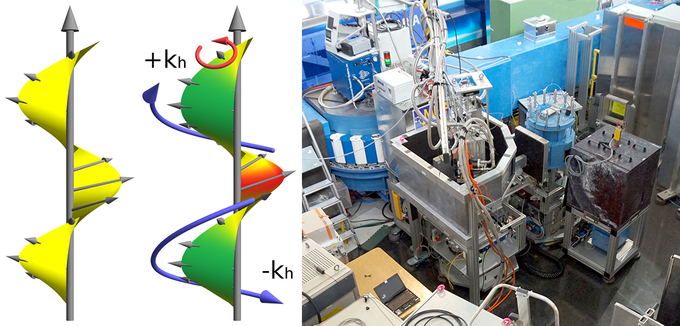Mit Neutronen die Dynamik von magnetischen Helices entschlüsselt
2015-09-03 – Nachrichten aus dem Physik-Department

Mangansilizium ist ein bevorzugter Kristall der Magnetforscher: er lässt sich schon länger als relativ großer Einkristall herstellen und eignet sich ganz besonders, um die magnetischen Eigenschaften zu erforschen. Nun ist theoretischen und experimentellen Physikern der TU München, des MLZ und der Universität zu Köln mit diesem Material gemeinsam ein besonderer Coup gelungen.
Von außen betrachtet zeigt Mangansilizium keinen Magnetismus, im Innern sieht das anders aus. Durch eine besondere Symmetrie der Kristallstruktur entsteht im Wechselspiel mit der klassischen Austauschwechselwirkung in Magneten eine spiralartige Struktur der magnetischen Momente, eine magnetische Helix. Diese ist viel länger als der typische Abstand zwischen zwei atomaren Gitterlagen des Kristalles.
Durch Neutronenstreuung haben TU-Wissenschaftler nun Anregungen dieser Helix nachgewiesen. Theoretiker der Universität zu Köln hatten bereits prognostiziert, dass es mehrere solche Anregungen, die mit einer Längsschwingung und zwei Drehschwingungen auf der Spirale identifiziert werden können, geben müsste. Bisher konnte eine solche Dynamik experimentell nicht belegt werden. Am Physik-Department der TUM wurden nun diese Anregungen mit Mikrowellen gemessen und am MLZ mit Neutronen.
Die MLZ-Wissenschaftler Max Kugler und Georg Brandl, die mit diesen Experimenten promovieren, und die Instrumentwissenschaftler Robert Georgii und Klaus Seemann haben das Instrument MIRA FRM II so umgebaut, dass damit auch Dreiachsenmessungen möglich sind und so die Anregungen der schraubenartigen magnetischen Struktur nachgewiesen werden können. Die Theoretiker haben dabei bereits ein mathematisches Berechnungsmodell aufgestellt, das diese Schwingungen für alle helikalen Magneten beschreibt und nur einfach messbare Materialkonstanten enthält. Zukünftig ist es also möglich, rein mathematisch und ohne aufwändige Neutronenstreuung die Schwingungen der magnetischen Momente eines helikalen Kristalls zu bestimmen. Nötig sind dazu nur einige wenige Parameter, die mit einem einfachen Magnetometer in jedem Labor gemessen und anschließend in die Formel eingegeben werden können.
Robert Georgii ist begeistert von dem Experiment: „Das ist ein wunderbares Beispiel für den Erfolg von Grundlagenforschung! Allerdings habe ich selten ein Experiment gesehen, das auf Anhieb funktioniert und so eindeutige Ergebnisse geliefert hat und das wiederum ist der engen Zusammenarbeit zwischen Theorie und Experiment geschuldet.“
- Redaktion
- Christine Kortenbruck (FRM II), Dr. Johannes Wiedersich (Physik-Department)
Veröffentlichungen
- Band structure of helimagnons in MnSi resolved by inelastic neutron scatteringM. Kugler, G. Brandl, J. Waizner, M. Janoschek, R. Georgii, A. Bauer, K. Seemann, A. Rosch, C. Pfleiderer, P. Böni, and M. Garst
- Universal helimagnon and skyrmion excitations in metallic, semiconducting and insulating chiral magnetsT. Schwarze, J. Waizner, M. Garst, A. Bauer, I. Stasinopoulos, H. Berger, C. Pfleiderer and D. Grundler
Verwandte Meldungen
- Einheitliche Theorie für Skyrmionen-Materialien – 2015-03-02
- Wolfram-Prandl-Preis für Dr. Marc Janoschek – 2014-09-23
- Kompakte und langlebige Speicherung von Informationen in magnetischen Wirbeln: Magnetische Monopole löschen Daten – 2013-05-31
- Daten speichern in Wirbelstrukturen – 2012-03-05
- TUM-Physiker entdecken mit Neutronen neue Wege zur Datenspeicherung – 2010-12-17
Links
Kontakt
- Prof. Dr. Peter Böni
- Technische Universität MünchenJames-Franck-Str. 185748 GarchingTel.: +49 89 289-14711E-Mail: peter.boeni@tum.de